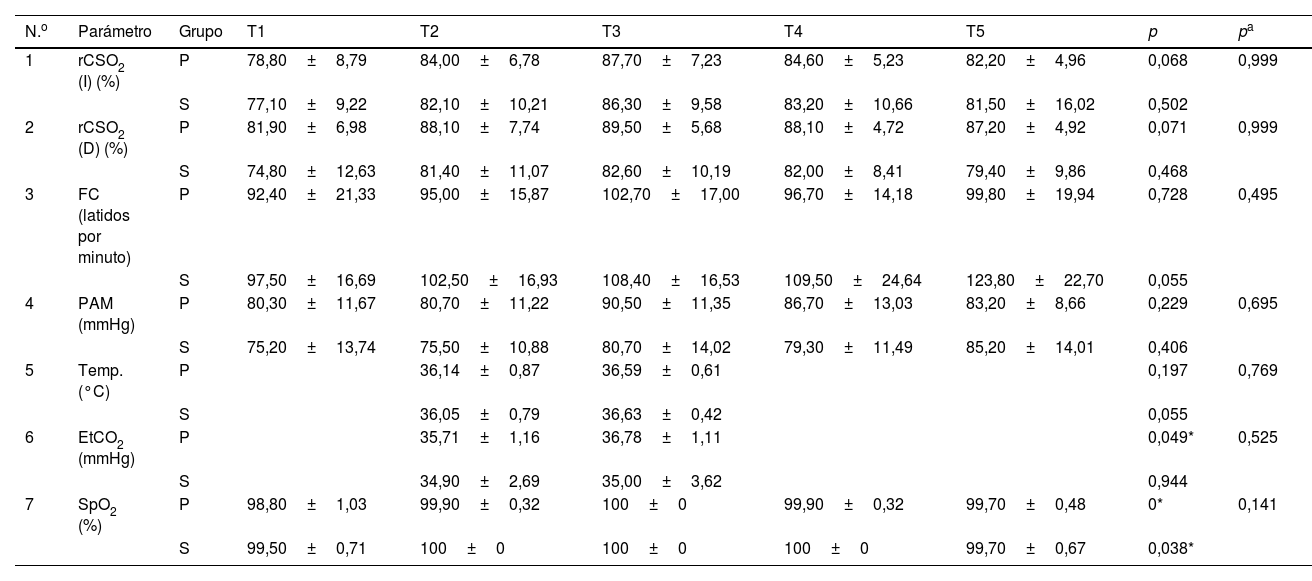La anestesia para cirugía de la enfermedad de Moyamoya (EMM) tiene efectos diferentes en la fisiología cerebral. Tanto sevoflurano como propofol tienen efectos protectores del cerebro, aunque con mecanismos diferentes. Utilizamos espectroscopia de infrarrojo cercano (NIRS) para observar el efecto de sevoflurano y propofol en el valor de rSO2 en pacientes pediátricos sometidos a cirugía de la EMM.
Materiales y métodosIncluimos pacientes pediátricos con grado I de ASA de 1 a 18 años de edad, sometidos a cirugía de la EMM a lo largo de un periodo de un año (del 1 de abril de 2018 al 1 de abril de 2019). Aleatorizamos a los pacientes en dos grupos: grupo S (sevoflurano) y grupo P (propofol). Se registraron los valores de NIRS en 5 puntos temporales: T1 (basal) T2 (tras la preoxigenación), T3 (tras la inducción), T4 (al final de la cirugía), T5 (tras la extubación). Se utilizó la prueba ANOVA unidireccional para realizar las comparaciones intragrupo y las medidas repetidas ANOVA bidireccionales con la corrección de Bonferroni para las comparaciones entre los grupos. Se consideró significativo un valor de p<0,05.
ResultadosSe incluyó en el estudio un total de 20 pacientes. La edad media fue de 10,5±4,3 años. El valor medio basal de rSO2 fue de 78,35±10,58 y 77,95±8,81 en los hemisferios derecho e izquierdo, respectivamente. En ambos grupos, los valores de rSO2 se incrementaron entre el valor basal y la inducción de la anestesia, reduciéndose ligeramente al finalizar la cirugía. El análisis entre grupos no reflejó cambios estadísticamente significativos entre los valores de rSO2.
ConclusiónTanto sevoflurano como propofol mantienen niveles adecuados de rSO2 en niños sometidos a cirugía por EMM.
Número de registro de ensayos clínicos: CTRI/2018/04/013229 registrado el día 12.04.2018.
Anaesthesia during surgery for moyamoya disease (MMD) has different effects on cerebral physiology. Both sevoflurane and propofol have cerebral protective effects, albeit with different mechanisms. We used near infrared spectroscopy (NIRS) to observe the effect of sevoflurane and propofol on rSO2 in paediatric patients undergoing MMD surgery.
Materials and methodsWe included paediatric patients ASA grade I aged between 1 and 18 years undergoing surgery for MMD over a period of 1 year (from 1 April 2018 to 1 April 2019). Patients were randomized to 2 groups: Group S (sevoflurane) and Group P (propofol). NIRS values were recorded at 5 time points: T1 (baseline) T2 (after preoxygenation), T3 (after induction), T4 (end of surgery), T5 (after extubation). One-way ANOVA was used for intra-group comparisons and two-way repeated measures ANOVA with Bonferroni correction were used for inter-group comparisons. P value <0.05 was considered significant.
ResultsA total of 20 patients were included in the study. The average age was 10.5±4.3 years. The mean baseline rSO2 was 78.35±10.58 and 77.95±8.81 in the right and left hemispheres, respectively. In both groups, rSO2 values increased between baseline and anaesthesia induction and fell slightly at the end of surgery. The inter-group analysis showed no statistically significant change between rSO2 values.
ConclusionBoth sevoflurane and propofol maintain adequate rSO2 levels in children undergoing surgery for MMD.
Clinical trial registration number: CTRI/2018/04/013229 registered on 12.04.2018.














